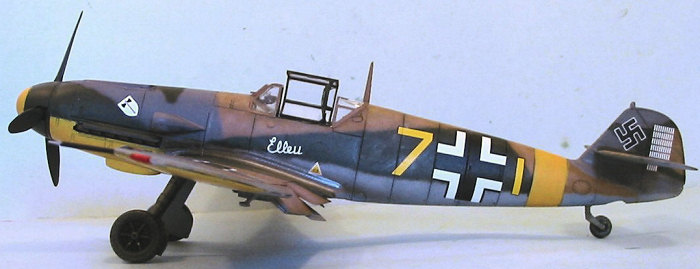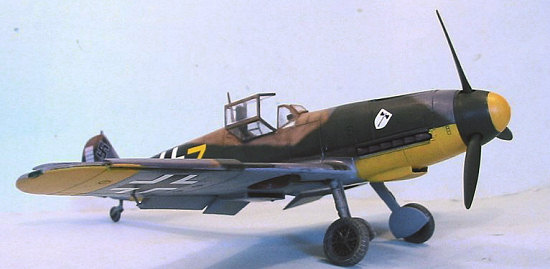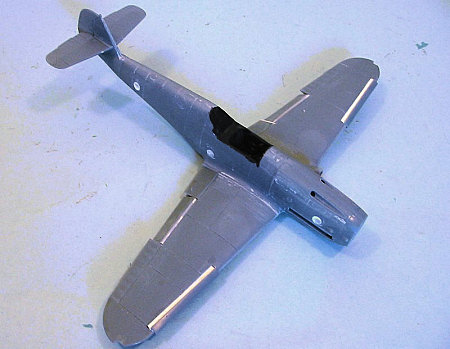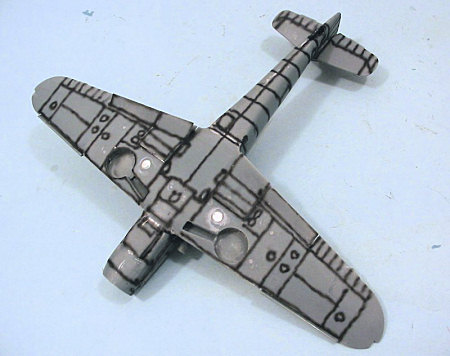
21st Century Toys 1/32 Bf-109F
| KIT #: | ? |
| PRICE: | $9.95 MSRP |
| DECALS: | Three options |
| REVIEWER: | Tom Cleaver |
| NOTES: |

| HISTORY |
The Bf-109F Friedrich series is commonly considered the best of the 109 series. It had the best combination of power, weapons and maneuverability of the entire series. The later Gustav and Kurfurst series of 109s did not see performance increases that were the equal of the aerodynamic penalties they imposed in terms of weight and overall performance. In his book, “I Flew For The Fuhrer,” Heinz Knoke pointed out that due to its weight penalty, the Gustav series had to be flown at full throttle while in the landing pattern with gear and flaps down.
The
Friedrich series was an attempt to completely improve the Bf-109 in terms of all
flight regimes to take full advantage of the increased power available from the
DB601E and DB601N engines during its production life. With development
commencing in the Spring of 1940, the Friedrich was primarily distinguished from
the previous Bf-109E series by the refined, more aerodynamically-streamlined
symmetrical cowling. The supercharger air intake was redesigned and positioned
further out from the cowling to increase the ram effect. The wing was modified
by having the slotted ailerons replaced by Frise-type ailerons of slightly less
span and greater chord. Armament was modified by removing the wing-mounted 20mm
cannons and replacing these with a cannon
 mounted on the centerline firing
through the airscrew hub. Originally a 20mm MG-FF was used on the Bf-109F-1;
this was changed to a 15mm MG151 from the Bf-109F-2, and finally to a 20mm MG151
on the Bf-109F-4. The Bf-109F-1 and F-2 were powered by the DB601N of 1,175 h.p.,
with the 1.350 h.p. DB-601E introduced on the Bf-109F-3.
mounted on the centerline firing
through the airscrew hub. Originally a 20mm MG-FF was used on the Bf-109F-1;
this was changed to a 15mm MG151 from the Bf-109F-2, and finally to a 20mm MG151
on the Bf-109F-4. The Bf-109F-1 and F-2 were powered by the DB601N of 1,175 h.p.,
with the 1.350 h.p. DB-601E introduced on the Bf-109F-3.
The first Bf-109Fs, which were likely pre-production Bf-109F-0s, were sent to JG 51 in early October 1940. Geschwader Kommodore Werner Mölders and his stab flight being provided these aircraft. He scored his 43rd victory in a Bf-109F-0 on October 11, 1940, and another two Spitfires on October 25.
While Mölders became the leading exponent of the new Bf-109, Oberstleutnant Adolf Galland of JG 26 and Major Walter Oesau of JG 3 refused to fly the airplane, considering it a “retrograde” development for its reduced armament. Galland argued that while an outstanding shot like himself or Mölders could use the centerline armament, the average squadron pilot needed the additional weight of fire of two 20mm cannon in the wings to maximize the opportunity for success. Both Galland and Oesau refused to fly the airplane while there were parts for their Bf-109Es, and Galland didn’t relent until the late Spring of 1941 when two special Bf-109F-6s were specifically created for him: one with two 13mm machine guns in the engine cowling and a 20mm MG151, and one with two 20mm MG-FF cannons in the wings.
In the meantime, the Bf-109F suffered structural failures commencing in February 1941, with several unexplained crashes of otherwise-competent pilots who entered dives and were unable to pull out successfully. This was eventually traced to the fact that the Friedrich series had dropped the external braces of the horizontal stabilizer used by all previous versions. This was accompanied by the use of stronger but less ribbing in the tail, which altered the proportion of rigidity to the strength of the tail. The result was that the tailplane had a frequency of oscillation that was overlapped by the engine at certain rpm’s, and the resultant sympathetic vibrations tore out the tail spars.
With
this fault remedied, the Geschwader on the Channel Front began rapid
re-equipment with the Friedrich commencing in March 1941. By May, very few
Bf-109Es were left there. The Friedrich came as a nasty surprise to the RAF,
which had only just managed to come up with a Spitfire that had a higher
performance than the Bf-109E by the introduction of the Spitfire V. Once again,
the Spitfire and the Bf-109 were so evenly matched that pilot skill was the
deciding factor, and in this the Germans were superior at the time.
One of the more successful, but still a lesser-known experte to fly the Friedrich was Viktor Bauer. Bauer joined the Luftwaffe in 1936, and was assigned to JG 2 upon completion of training. He moved on to JG 77 in March 1940 and served with 1st Staffel through the French campaign and the Battle of Britain. He was transferred to 9th Staffel of JG 3 in November 1940, by which time he had three victories. In June , 1941, just before the invasion of Russia, he was promoted to Staffelkapitän of 9.JG 3, with 4 victories total.
Bauer’s star began to shine on the Eastern Front. In June 1941 he shot down 15 Soviet aircraft, including 5 SB-2s on June 26. July saw him claim 17 victories, including five DB-3 twin-engine bombers on July 12. By then promoted to Oberleutnant, Bauer was awarded the Ritterkreuz on July 30 for 36 victories. Badly wounded in combat with Soviet bombers on July 23, Bauer made an emergency landing. Badly wounded enough to spend several months in hospital, Bauer returned to combat February 1942, and claimed his 40th victory on February 18, with number 50 on April 4. He shot down 4 I-16s in one combat on May 22. Flying a Bf-109F-4, Bauer was spectacularly successful during July, 1942, when he claimed a total of 33 victories. He shot down four in a day five times and twice recorded five victories in a day. On July 26 he was awarded the Eichenlaub for scoring 102 victories. On August 9, he scored his 106th and final victory, but was wounded in action a day later. Following his recovery from wounds, Bauer was appointed a Staffelkapitän in Ergänzungs-Jagdgruppe Ost. Major Bauer was appointed Gruppenkommandeur of Ergänzungs-Jagdgruppe Ost in July 1943, a position he held until November 1944. On December 1, 1944, Oberst Bauer was appointed Kommodore of Ergänzungs-Jagdgruppe 1, which position he held until the end of the war.
Viktor Bauer was credited with 106 victories in 400 missions. His 102 victories on the Eastern front included 27 Il-2 Sturmoviks.
| THE KIT |
Modelers have been waiting for Hasegawa to release a 1/32 Bf-109F ever since it was noticed that the sprue for the top cowling part in the Bf-109G-4 kit was labeled “Bf-109F.” That was four years ago, and as of this writing there is no news that Hasegawa will release a Friedrich.
 Twenty-First Century Toys
is known as a maker of diecast and pre-assembled “collectible” models. Their
quality has improved as regards accuracy of the model and its markings ever
since Roy Sutherland was brought aboard in 2003 to supervise this area of model
development. These “kits” are primarily toys, not serious scale models and have
been disdained by “serious modelers” since they began crowding out “real” models
on hobby shop shelves in recent years, though the shop owners have no
complaints, given that these models sell better than the kits they replaced.
Twenty-First Century Toys
is known as a maker of diecast and pre-assembled “collectible” models. Their
quality has improved as regards accuracy of the model and its markings ever
since Roy Sutherland was brought aboard in 2003 to supervise this area of model
development. These “kits” are primarily toys, not serious scale models and have
been disdained by “serious modelers” since they began crowding out “real” models
on hobby shop shelves in recent years, though the shop owners have no
complaints, given that these models sell better than the kits they replaced.
Recently, Twenty-First Century decided to release some kits that are not pre-assembled and painted. These include the Bf-109F, the A6M2, the Macchi C.202, the Junkers Ju-87B and the F4U-1A Corsair. These are all available exclusively through WalMart in the United States, and have not been released elsewhere.
 While these kits are obviously toys, the decal sheets are first-rate, and
provide markings never before done by any other kit or aftermarket sheet in 1/32
scale. For the Bf-109F, this includes markings for the well-known Bf-109F-4/B
fighter bomber flown by Oberleutnant Frank Liesendahl as
Staffelkapitän of 10(Jabo)/JG 2, the Bf-109F-2 flown by Leutnant Max-Hellmuth
Ostermann of 7./JG 54 in 1941, and the Bf-109F-4 flown by Oberleutnant Victor
Bauer as Staffelkapitän of 9./JG 3 in July 1942.
While these kits are obviously toys, the decal sheets are first-rate, and
provide markings never before done by any other kit or aftermarket sheet in 1/32
scale. For the Bf-109F, this includes markings for the well-known Bf-109F-4/B
fighter bomber flown by Oberleutnant Frank Liesendahl as
Staffelkapitän of 10(Jabo)/JG 2, the Bf-109F-2 flown by Leutnant Max-Hellmuth
Ostermann of 7./JG 54 in 1941, and the Bf-109F-4 flown by Oberleutnant Victor
Bauer as Staffelkapitän of 9./JG 3 in July 1942.
The kit further betrays its parentage in the fact that, out of the box with no modification, it makes up into a Bf-109G-2, rather than any Friedrich. However, the effort to turn it into a full F-series 109 is not difficult. In fact, several of the parts - like the spinner and the upper fuselage cowling part - are more accurately shaped than the similar parts from the Hasegawa kit. In addition, the wheel wells are the correct fully-round type for the Friedrich, which will not be found on the Hasegawa kit when it is finally released.
After examining his kit, Dave Thompson told me that it would be an excellent “aftermarket source” of correct parts and accurate decals to turn the Promodeler Bf-109G-4 kit into a Friedrich. This is certainly borne out by the price, which is only $9.95, which is less than many aftermarket decal sheets.
| CONSTRUCTION |
Roy Sutherland sent me this kit and asked that I build it as a “serious” model. It turns out, that is not as hard to do as one might think.
I stared by re-shaping the prop blades, narrowing them from the broad-chord Gustav prop to a narrow-chord Friedrich prop. This took all of about 5 minutes with a sanding stick. I then sanded down the oil cooler so it was the shallower type used by the Friedrich. This took another 5 minutes.
Construction got going with the cockpit. I decided to use some Hasegawa parts I
had left over from previous projects. This was mostly curiosity on my part to
see how interchangeable things were, and were certainly not necessary in
creating a good  model. What is
there in the kit will make up into an accurate-enough cockpit for most modelers
doing this. I painted the cockpit parts with Xtracrylix RLM66 Black-Grey, and
then did some detail painting of the instrument panel and other panels to add
some color. I was going to use Eduard Luftwaffe seatbelts, but these had not
arrived by the time I needed to have the review done, so that will come later.
model. What is
there in the kit will make up into an accurate-enough cockpit for most modelers
doing this. I painted the cockpit parts with Xtracrylix RLM66 Black-Grey, and
then did some detail painting of the instrument panel and other panels to add
some color. I was going to use Eduard Luftwaffe seatbelts, but these had not
arrived by the time I needed to have the review done, so that will come later.
The fuselage assembled easily. The plugs to cover the holes for the screws are made of rubber. I threw these away and made plastic plugs with Evergreen sheet, glued them in place, filled them with cyanoacrylate glue, then covered them with Mr. Surfacer, and sanded them out of existence. I also made sure to fill and sand away the “panel line” created by attaching the upper cowling part, since that was not present on the real thing. I also sanded off the two intakes on either side of the nose, since these were associated with the later versions.
The wing comes with the flaps and cooling radiators closed. I decided I wanted them opened and dropped. This was easily accomplished with a razor saw. Modelers who have been around long enough to have built their share of Otaki and Revell 109s in 1/48 will remember how this is done. Again, I have seen other examples of this kit built up where the modeler did not do this, and they looked fine.
I also opened up the rear fuselage for the tail wheel well. This was easily done with a #11 X-acto blade, and the tail wheel will still attach without problems. I opened up the ring attachment on the gear leg so I could attach it after the model had been painted.
I used Evergreen sheet to make the interior area of the wing below the slats, since the kit leaves this area open.
The kit does not provide the aileron mass balances. I scratchbuilt these with Evergreen sheet and rod.
| COLORS & MARKINGS |
Painting:
I had no problem choosing to do Bauer’s airplane, since it had one of those field-applied Eastern Front camouflage schemes that look so much more interesting than the standard 74/75/76.
This
airplane was apparently one of many delivered to JG 3 that had been painted in
desert camou flage at the
factory. Once they arrived on the eastern front RLM 75 Grauviolett and
RLM70 Schwartzgrun were applied over the RLM 79 Tan, while the lower
surfaces remained in RLM 78, the Luftwaffe’s version of Azure Blue. I first
painted the yellow areas on the fuselage, under the nose, the front of the
spinner and under the wingtips with Xtracrylix RLM 04 Gelb, after
applying a flat white base. These were then masked off and I pre-shaded the
model with flat black. I then applied Xtracrylix RLM 78 on the lower surfaces,
and freehanded the upper camouflage with Xtracrylix RLM 79 Tan, RLM 75
Grauviolett and RLM 70 Schwarzgrun, which was also applied to the spinner and
the prop.
flage at the
factory. Once they arrived on the eastern front RLM 75 Grauviolett and
RLM70 Schwartzgrun were applied over the RLM 79 Tan, while the lower
surfaces remained in RLM 78, the Luftwaffe’s version of Azure Blue. I first
painted the yellow areas on the fuselage, under the nose, the front of the
spinner and under the wingtips with Xtracrylix RLM 04 Gelb, after
applying a flat white base. These were then masked off and I pre-shaded the
model with flat black. I then applied Xtracrylix RLM 78 on the lower surfaces,
and freehanded the upper camouflage with Xtracrylix RLM 79 Tan, RLM 75
Grauviolett and RLM 70 Schwarzgrun, which was also applied to the spinner and
the prop.
When all was dry, I gave the model an overall coat of Xtracrylix Gloss Varnish.
Decals:
The kit decals went on as nicely as they were printed. A light coat of Micro-sol was all it took to snug them down without problems.
I used the resin wheels from a Promodeler Bf-109G kit instead of the kit-supplied wheels. Exhaust stains and oil stains were applied with Tamiya “Smoke.”
| CONCLUSIONS |
 With only a bit of effort,
this “toy” can become a “serious model” that can successfully sit next to all my
Hasegawa 109s and look like it belongs there. Serious modelers who look down on
this kit are missing a real bargain and an easy way to provide a Bf-109F in
their large-scale collection. A modeler could go “whole hog” on this kit with
Eduard photoetch for the cockpit interior, seat belts, etc., and come up with a
contest-winning “serious model.” The only skills needed to make the changes are
an ability to use sanding sticks and a razor saw.
With only a bit of effort,
this “toy” can become a “serious model” that can successfully sit next to all my
Hasegawa 109s and look like it belongs there. Serious modelers who look down on
this kit are missing a real bargain and an easy way to provide a Bf-109F in
their large-scale collection. A modeler could go “whole hog” on this kit with
Eduard photoetch for the cockpit interior, seat belts, etc., and come up with a
contest-winning “serious model.” The only skills needed to make the changes are
an ability to use sanding sticks and a razor saw.
This kit can be successfully turned into a nice model by anyone from a beginning working on their first model to someone who has been building 109s since the days when Tyrannosaurus Rex was swatting down the originals.
And at this price, it is indeed a good “aftermarket set” for those who want to modify the Hasegawa kit.
March 2005
Copyright ModelingMadness.com
Thanks to Roy Sutherland for the review copy.
If you would like your product reviewed fairly and fairly quickly, please contact the editor or see other details in the Note to Contributors.
Back to the Review Index Page 2020